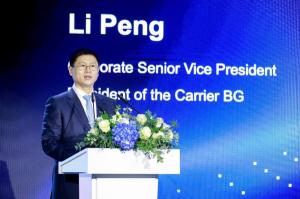The Huawei Green ICT Summit was held in Barcelona on Feb. 27 (local time). Peng Song, president of ICT Strategy & Marketing of Huawei, delivered a keynote speech entitled “Green & Development, Choosing Not to Choose”. Peng pointed out that an AI big bang is underway. AI brings new benefits and opportunities to operators. However, it also requires better ICT infrastructure, due to higher bandwidth and increased computing power, leading to a rapid increase in network energy consumption.
“The ICT industry seems to be faced with the tough choice to either go green or develop. However, we believe the industry can choose not to choose, and instead go green and develop simultaneously,” Peng said.

Peng pointed out that simultaneous green ICT and ICT development is possible if the right balance is struck between energy efficiency, renewable energy utilization, and user experience. At MWC Barcelona 2023, Huawei will launch solutions that embody this approach to pave the way for the green development of ICT infrastructure networks.
In terms of energy efficiency, Huawei advocates expanding the focus from just improving network energy efficiency to also reducing absolute energy consumption. In light-load scenarios, multidimensional shutdown technology can be employed to enable intelligent shutdown across different dimensions, such as frequency, time, channel, and power. Meanwhile, in ultra-light-load scenarios, equipment can be put into a deep dormancy mode. For example, new materials and processes can be used to solve condensation and low temperature issues when AAU hardware shuts down. This enables the power module to independently remain in standby, meaning the power consumption of the AAU during extremely light load can be reduced from 300 W to less than 10 W.
In terms of renewable energy, the company calls for a focus expansion, from the scale of green power deployment to the efficient use of renewable energy. An upgrade from network-specific policies to site-specific policies can be undertaken in order to improve the accuracy of renewable energy deployment. Additionally, the time required for intelligent scheduling can be reduced from days to minutes, thus maximizing the economic and environmental benefits of renewable energy. Multi-dimensional site information such as weather, electricity price, battery status, and service volume can be obtained, and intelligent scheduling algorithms can maximize power generation efficiency and load-based power availability, while minimizing overall power cost.
In terms of user experience, Huawei proposes that the focus should no longer solely be on network energy saving and KPI assurance, but extend to user experience assurance. Optimal energy saving policies can be adopted according to different network scenarios. In low-traffic scenarios, basic network KPIs are guaranteed to maximize energy saving, while user experience is guaranteed in high-traffic scenarios. Experience-driven approaches are being upgraded to data-driven approaches, allowing energy-saving policies to be generated in minutes and optimization policies to be delivered in milliseconds.
Peng emphasized that Huawei iteratively updates its green solutions in accordance with its belief in the potential of the three aforementioned areas, and has launched the Huawei Green 1-2-3 solution. Within this solution, “1” refers to one index for green network construction; “2” refers to the focus on two scenarios: high energy efficiency and ultra-low energy consumption; and “3” refers to a systematic three-layer solution that covers sites, networks, and operations. Peng closed his speech by highlighting Huawei’s willingness to work with operators worldwide to strike a balance between going green and development, in order to accelerate green ICT development.

